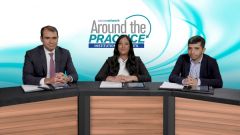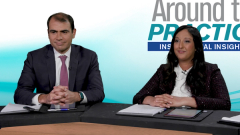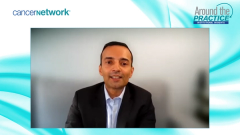
Overview of BCMA-Targeting Bispecific Antibodies in Relapsed/Refractory MM
A broad perspective on the development of BCMA-targeted bispecific antibodies for patients with relapsed/refractory multiple myeloma.
Episodes in this series

Transcript:
Ajai Chari, MD, PhD:Let's get things rolling. Al, if you could summarize the data on which this exciting teclistamab approval was made?
Alfred L. Garfall, MD, MS: Thanks, Ajai. It's an exciting time and very exciting data that led to the recent accelerated approval of teclistamab. The approval was based on data from the MajesTEC-1 study, of course, as a dose escalation study with intravenous dosing of teclistamab transitioned over time after identifying a recommended phase 2 dose of 1,500 micrograms per kilogram or 1.5mg per kilogram administer as a subcutaneous injection once weekly. That was the recommended phase 2 dose. In that phase 2 portion of the study identified a response rate of around 63% with most of those responses being very good partial responses or better. Those responses being very durable with about 70% of patients after a year of therapy remaining in response. As you saw in the cases we discussed, patients can remain in response to this medication for a very long time. That's kind of the headline efficacy data from that study that led to the approval.
Ajai Chari, MD, PhD:I'm curious for Krina and Sham, is 60 to 100 the new 20 to 30? Are you impressed by these results?
Krina K. Patel, MD, MSc: Yes, those are phenomenal. For us, as I was saying before, we're all sort of the millennial doctors that came in maybe in the last 10 years. For us, this is going to be our new normal. If you see something lower than that, it's still good. That brings up the piece though that our patients are relapsed refractory and we can't expect every drug to be like this, especially now that we have so many more drugs to now say that patients who are refractory to teclistamab or to a CAR-T to then have a 60 or 100 percent response rate if they're 7th or 8th line, makes it difficult. We're going to have to move it to earlier to see how these new drugs come in but I think the response rates, at least for our generation, are pretty amazing.
Ajai Chari, MD, PhD:Sham, there's a lot of research being done, multiple agents. We'd love to hear your thoughts on one of those other agents. Also, do we need all these agents? Is this good for the field or not?
Sham Mailankody, MD: Yes. Teclistamab is the first to be approved, but there's probably at least a half a dozen other BCMA bispecific antibodies in clinical development. Elranatamab for one. There are several others that are completing phase 1/2 studies, and they all look quite promising, I would say. Cross-trial comparison, small numbers, but broadly, they all are showing responses in the order of 60% to 80%, 90%. Lots of good PGR, CRs, durable responses. That's a good thing for a couple of reasons. One, more products are always better than myeloma. We're used to having multiple drugs of the same class. Thalidomide, lenalidomide, pomalidomide, velcade, carfilzomib, ixazomib. It's good to have multiple drugs that target the same class. It provides more opportunities for patients to be treated with these drugs. We'll get into this later in the discussion. There's also a role for multiple sequential BCMA therapies, either of the same modality or different modalities. There are certainly opportunities to use these drugs in a logical fashion and provide our patients with the longest possible remissions and responses.
Ajai Chari, MD, PhD:Krina, could you walk us through the MagnetisMM study? As Sham mentioned, elranatamab is one of the other drugs that's also been quite active in development.
Krina K. Patel, MD, MSc: BCMA bispecifics. The next other big drug we're all looking at is elranatamab. I'll call it ELRA because I have dyslexia sometimes. Again, the phase 1 study really had relapsed refractory patients, over 90% triple class refractory. I think 29% had high-risk features. They found their doses. The priming dose of 44mg and the RPT2 dose of 76mg. At the higher doses, really their CRS grade, again, about 66%, mostly all grade 1/2. The neurotoxicity that they saw for a little bit, in their phase 2 study in the MagnetisMM-3 where they had 123 patients at the higher doses. They did have about 17% neurotoxicity. Again, all grade 1/2 and mostly reversible, but just something we can talk about throughout the adverse effects that we talk about with our different agents, but the response rate, 64%. Again, we're hitting these great response rates in these relapsed refractory patients and about 38% with those deep responses, CRs or better. Again, just another fantastic drug. Then people ask all the time, do we need a second BCMA bispecific? It's sort of like with the CAR-Ts and with the CD38s. It will come down to, in the real world, how are we able to give these drugs safety-wise, efficacy-wise, and then cost. I think that's going to play a big role of which hospitals and which patients can get different drugs.
Ajai Chari, MD, PhD:To orient our audience to the high-level summary of these various constructs out there. I believe we have a table. I can just summarize for the group that I want to hear all your thoughts about these. Starting from the left, we have AMG701. Then we have CC93269, elranatamab which you just heard about. There's HPN217. Regeneron 4548. Teclistamab and then finally TNB33, 3B. Some of the salient differences is the route of administration and frequency. Most of them are IV but we have a couple that are sub-cu, including ELRA and TEC. Most of them are weekly, but the TMB compound is every 3 weeks. The sample sizes vary. I should mention that a lot of these data may be updated at this year's ASH [American Society of Hematology meeting 2022] meeting. The largest, as we heard about from AL was teclistamab with 165 patients. The other sample sizes are also increasing. The number of patients that have been treated in bispecifics already far exceeds CAR-T. It's foreshadowing into what's going to happen in the real world. Then the lines of therapy are comparable. We're looking at heavily treated patients, high representation of triple class refractory. Again, you're seeing across the board, the very fact that these are phase 1 studies and we're talking about responses, which we were never taught to do that. It's really all about safety but look, across the board, you're seeing 60 plus response rates at the RP2Ds and the duration of response is quite encouraging. Just to throw back to the group, what do you guys think? Just so for the folks that may not be as myeloma-focused, how deep and durable are these responses? Al, I'll start with you since you highlighted the TEC, the PFS, and the DOR. Anything striking about these constructs compared to what we're used to in relapsed refractory myeloma?
Alfred L. Garfall, MD, MS: You started the conversation with the important context, which is that for so long we had new drugs from myeloma that had single agent response rates in the 20 to 30% range. Just look at the dramatic transformation in overall survival we've seen with those drugs as they've been incorporated into earlier lines of therapy. At least a doubling of survival expectations from multiple myeloma patients from those drugs that had 20% to 30% response rates. Now we're talking about a series of medications with new mechanism of actions that double at least those response rates. That foreshadows remarkable improvements in overall survival for multiple myeloma patients. It's hard to disentangle differences between these phase 1 studies, except to say that they're all remarkable. I don't think we've seen, except for CAR T-cell, which obviously are another important class of therapy. In the class of pharmaceuticals, conventional medications that you can give kind of off the shelf, as they say, this is unprecedented breakthrough in terms of these medications for the field, this new class of medications with such high response rates and duration of response with single-agent activity, often with the convenience of a subcutaneous injection. My experience was mainly with teclistamab or has been mainly with teclistamab and it is remarkable. While there are some real adverse effects and toxicities that you have to pay attention to in the early going, patients who achieve response is like the patients that were in our case discussions, as you can probably attest, kind of coming in for weekly subcutaneous or biweekly subcutaneous injections. It's a simple therapy compared to just about anything that those patients were on before they started teclistamab.
Transcript edited for clarity.
Newsletter
Stay up to date on recent advances in the multidisciplinary approach to cancer.





































































































